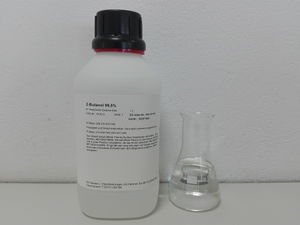sec-Butanol
 sec-Butanol bottle and sample
| |
| Names | |
|---|---|
| IUPAC name
Butan-2-ol
| |
| Other names
2-Butanol
2-Butyl alcohol sec-Butyl alcohol | |
| Identifiers | |
| Jmol-3D images | Image |
| |
| Properties | |
| C4H10O | |
| Molar mass | 74.12 g/mol |
| Appearance | Colorless liquid |
| Odor | Fruity, alcoholic |
| Density | 0.8063 g/cm3 (at 20 °C) |
| Melting point | −115 °C (−175 °F; 158 K) |
| Boiling point | 98 to 100 °C (208 to 212 °F; 371 to 373 K) |
| 125 g/l (at 20 °C) | |
| Solubility | Miscible with diethyl ether, ethanol, methanol Very soluble in acetone |
| Vapor pressure | 1.67 kPa (at 20 °C) |
| Thermochemistry | |
| Std molar
entropy (S |
213.1 J·K-1mol-1 |
| Std enthalpy of
formation (ΔfH |
−343.3–−342.1 kJ·mol-1 |
| Hazards | |
| Safety data sheet | Sigma-Aldrich |
| Flash point | 24 °C (75.2 °F; 297 K) |
| Lethal dose or concentration (LD, LC): | |
| LD50 (Median dose)
|
2.193 mg/kg (rat, oral) |
| Related compounds | |
| Related compounds
|
Butanol Isopropanol Methyl ethyl ketone |
| Except where otherwise noted, data are given for materials in their standard state (at 25 °C [77 °F], 100 kPa). | |
| Infobox references | |
sec-Butanol or 2-butanol is an isomer of butanol, mainly used as a precursor to the more common methyl ethyl ketone.
Contents
Properties
Chemical
sec-Butanol can be oxidized to butanone aka methyl ethyl ketone using Jones reagent.
sec-Butanol burns in air to release carbon dioxide and water vapors.
Physical
2-Butanol is a colorless liquid, with a strong smell. It melts at −115 °C and boils at 99.5 °C, just slightly below the boiling point of water.
Availability
2-Butanol is sold by various chemical suppliers.
Preparation
Can be made by reducing butanone using a reducing agent.
Projects
- Make butanone
- Make esters
Handling
Safety
sec-Butanol is prone to forming explosive peroxide over the course of several years, so it's best to check it periodically.
Storage
sec-Butanol should be kept in closed bottles, in the solvent cabinet.
Disposal
sec-Butanol should be tested for peroxides before disposal. If peroxides are present, a reducing agent such as sodium sulfite should be added to destroy the peroxides, then tested again to see if all the peroxides have been neutralized. If no peroxides are present, it can be safely burned.
However, unless the waste sec-butanol is very old (at least several years) and wasn't stabilized with an anti-oxidant, there is little chance of building up a dangerous amount of peroxides. Nonetheless, a peroxide test is recommended for safety reasons.
References
Relevant Sciencemadness threads
- Chemical pages without CAS Registry Number
- Articles without EBI source
- Chemical pages without ChemSpiderID
- Chemical pages without DrugBank identifier
- Articles without KEGG source
- Articles without InChI source
- Articles without UNII source
- Articles containing unverified chemical infoboxes
- Chemical compounds
- Organic compounds
- Alcohols
- Secondary alcohols
- Solvents
- Polar solvents
- Protic solvents
- Liquids
- Peroxide forming chemicals
- Air-sensitive materials